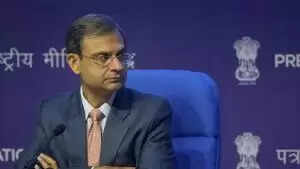What to Expect from RBI's Upcoming Monetary Policy Announcement: Insights and Predictions
RBI's Monetary Policy Meeting Set for April 9

Mumbai: The Reserve Bank of India (RBI) Governor Sanjay Malhotra is scheduled to unveil the first bi-monthly monetary policy for the fiscal year on Wednesday. This announcement comes with widespread anticipation of a potential 25 basis points cut in the short-term lending rate.
The Monetary Policy Committee (MPC), led by Governor Malhotra, commenced its three-day discussions on the upcoming credit policy on Monday.
In February, the MPC had reduced the repo rate by 25 basis points to 6.25 percent, marking the first decrease since May 2020 and the first adjustment in two and a half years.
Analysts predict that the RBI will again lower the rate by 25 basis points on Wednesday, driven by easing inflation and the necessity to boost economic growth amid challenges posed by tariffs from the Trump administration.
The RBI announced via social media that the Monetary Policy Statement by Governor @GovSMalhotra will be made public at 10:00 AM on April 9.
On the same day, US President Donald Trump is set to implement a significant 26 percent reciprocal tariff on India.
Interestingly, the MPC's decision will coincide with the initiation of these tariffs.
According to a report from HSBC Global Research, a 25 basis points cut in the repo rate is expected in April, bringing it down to 6 percent. The report also anticipates discussions on measures to maintain liquidity at surplus levels and potential downward revisions to growth and inflation forecasts. Following the April cut, two additional reductions of 25 basis points each are expected in the June and August meetings, ultimately lowering the repo rate to 5.5 percent, which is considered neutral.
Goldman Sachs also forecasts a 25 basis points reduction in the repo rate.
The first quarter has shown a slowdown in domestic activity, supported by benign inflation and a notable decline in Brent crude oil prices and the dollar index following Trump's tariff announcements, creating a conducive environment for the RBI to ease rates.
Goldman Sachs further noted that with expectations of headline inflation falling below 4 percent by Q4 CY25, they anticipate an additional 50 basis points of repo rate cuts in CY25, totaling 100 basis points in this cycle.
Rohit Arora, CEO and co-founder of Biz2Credit and Biz2X, remarked that with domestic inflation easing and a favorable CPI print, the timing for a rate cut seems appropriate.
However, the shifting global landscape, particularly the renewed tariff risks and narrowing interest rate differentials with the US, complicates the policy decision-making process.
Umesh Gowda H A, chairman and founder of Sanjeevini Group, expressed that the impact of Trump's tariffs on global growth will be significant, as trade slows in major economies.
He emphasized that with India's inflation declining, the RBI should consider a 50 basis points cut to encourage investment and meet global demand. A reduction in rates would also enhance consumer demand across various sectors, helping to mitigate global uncertainties.
Ashok Kapur, chairman of Krishna Group and Krisumi Corporation, anticipates that the central bank will support the economy and borrowers by reducing the policy rate by 25 basis points in the upcoming review.
This expected cut would inject more liquidity into the market, stimulate borrowing and spending, and boost economic activity. The housing sector, in particular, could see significant benefits, as lower interest rates would reduce home loan EMIs, making homeownership more accessible.
Ankita Pathak, macro strategist and global equities fund advisor at Ionic Asset by Angel One, also predicts a 25 basis points cut, with a shift in stance from neutral to accommodative.
While India is relatively insulated from tariffs compared to other Asian countries, it is unlikely to escape the effects of a global slowdown.
Pathak noted that downward revisions to growth and inflation are likely. India has needed monetary reflation even before the tariffs, and the current circumstances necessitate both rate cuts and the maintenance of surplus liquidity.
Ayush Lohia, CEO of Zuperia Auto, views the upcoming RBI monetary policy as a pivotal moment for the economy, expecting measures that will enhance growth and stimulate demand.
He highlighted that for the electric vehicle sector, lower interest rates and increased liquidity would significantly boost consumer adoption and drive industry growth.
The MPC comprises the Governor and two senior central bank officials, along with three members appointed by the government.
